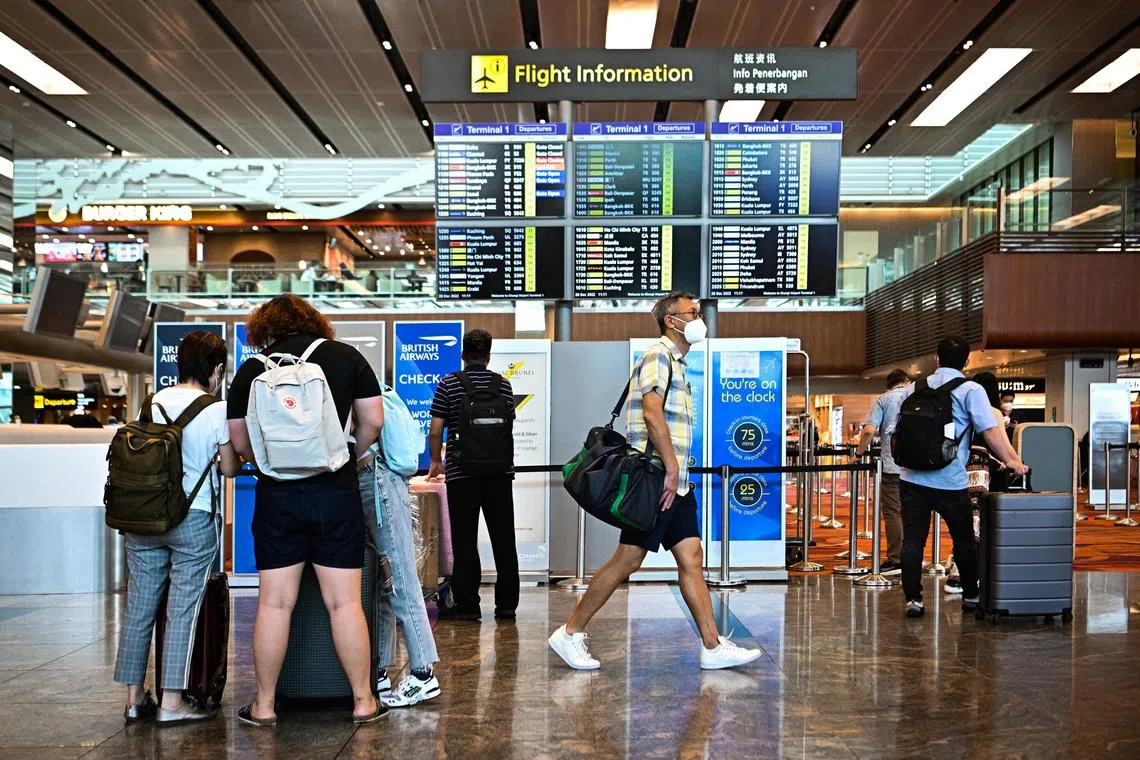2022 year in review: Changi Airport finishes top of Asia-Pacific as it recovers slower than expected
Sign up now: Get ST's newsletters delivered to your inbox

Weekly passenger numbers at Changi Airport reached 75 per cent of those pre-Covid-19, as at mid-December 2022.
ST PHOTO: LIM YAOHUI
Follow topic:
SINGAPORE - The word summing up aviation in Singapore in 2022 is, without a doubt, recovery, with Changi Airport finishing the year top of the Asia-Pacific.
As at mid-December, its weekly passenger numbers had reached 75 per cent of those pre-Covid-19,
All four of Changi Airport’s terminals are now also reopened and processing steady streams of passengers. The high-profile reopening of Terminal 4 the southern wing of Terminal 2
Adding to the positive indicators is Changi’s connectivity, now at 82 per cent of pre-pandemic levels. As at December, 95 airlines were scheduling flights from Changi Airport to 140 cities, including four new places that passengers three years ago could not book flights to – Noumea in New Caledonia, Jeju in South Korea, Pune in India and Sibu in Malaysia.
Amid a tentative recovery, eight new airlines have also been added to the airport’s roster, including Aircalin,
These various indices of passenger numbers, operating capacity and connectivity all point towards Changi Airport’s restoration of its position as Asia’s air hub, exceeding the 50 per cent year-end passenger traffic that at one point seemed a stretch.
By sheer international travel volume, it topped the Asia-Pacific region, beating Bangkok’s Suvarnabhumi Airport and Seoul’s Incheon International Airport by quite a distance: 32 million passengers handled to the other two’s 18 million each.
In terms of recovery, it is also finishing by as much as 10 percentage points higher than the South-east Asia average, said independent analyst Brendan Sobie.
Changi Airport’s recovery figure of 69 per cent of pre-Covid-19 levels in November is much higher than Suvarnabhumi Airport’s 56 per cent and Kuala Lumpur International Airport’s 52 per cent. They are Changi Airport’s closest competitors in South-east Asia.
“It has been clear for several months that Changi will end the year as by far the largest international airport in Asia-Pacific, up from the third spot in 2019,” said Mr Sobie.
“While Changi is now the largest international airport in the Asia-Pacific, that does not mean it has recovered the fastest. Several smaller airports in South Asia and Central Asia have recovered much faster while a few airports in South-west Pacific such as Sydney have recovered slightly faster.”
These were from a lower base in absolute numbers.
Hong Kong, which was the largest Asia-Pacific international airport pre-pandemic, slipped out of the rankings for the region’s largest international airport entirely, having just recently eased its border regulations.
The busiest international airport in the world remains Dubai International Airport, followed by London’s Heathrow Airport and Paris’ Charles de Gaulle Airport.
But despite the Asia-Pacific and Singapore’s recovery, a broader look at the whole year shows that 2022 still remained a difficult year for both airports and airlines. The Asia-Pacific continues to lag significantly behind other regions due to its slower reopening and China’s zero-Covid policy, which has only just shown signs of easing.
As a region, year-end figures fell short of International Air Transport Association (Iata) projections in June, remaining stuck at 43.4 per cent as at October compared with Iata’s anticipated 73 per cent.
Comparing the first 10 months of 2022 with January to October in 2019, the total number of passengers who passed through Changi Airport was also just 23.6 million, or 42 per cent of 2019 levels.
Mr Philip Goh, Iata’s regional vice-president for Asia-Pacific, said that while the months following the Asia-Pacific’s opening around April saw very strong year-on-year growth, the recovery was slower than expected.
Admitting that Iata’s initial forecast was overly optimistic, he added: “China’s zero-Covid approach so far has held back the region’s recovery. We are anticipating passenger traffic to reach 70 per cent of 2019 next year, but we need to watch what China will do in the next few months.”
In other regions, passenger traffic figures are already between 75 per cent and 90 per cent. Mr Goh added that airlines in the region collectively remain far from a full financial recovery, and can be expected to post a collective loss amounting to $10 billion this year.
National carrier Singapore Airlines, however, is optimistic, having posted an operating profit of $1.23 billion for the first half of the financial year ended Sept 30

SIA’s CEO Goh Choon Phong has painted an upbeat picture of the airline’s operating conditions, after the airline posted an operating profit of $1.23 billion in the first half of the financial year ending Sept 30.
ST PHOTO: ALPHONSUS CHERN
Its chief executive Goh Choon Phong said the airline was “recovering strongly from the Covid-19-era”. For the July to September quarter, SIA Group made a record operating profit of $678 million. In November, it was flying flights at 75 per cent of pre-Covid-19 volumes, with the confidence that about 86 per cent of the seats would be filled.
Almost all of SIA’s cabin crew and pilots are now back in active service, and it has resumed cadet pilot recruitment. It is also on track to hire 2,000 cabin crew by March
Mr Stefano Baronci, director-general of ACI Asia-Pacific, said that the Asia-Pacific, despite its slowness to recover, is still expected to fulfil its potential in the longer term.
He puts full recovery for the region at the end of 2024, after which Asia-Pacific passenger traffic will continue to grow to become the busiest in the world by some distance, contributing about 45 per cent of total global passenger traffic growth. Airlines across the world are still expected to fly close to 19.7 billion passengers by the 2040s – more than double the 2019 passenger traffic level.
Mr Baronci cites the ongoing conflict in Ukraine, which has affected jet fuel prices, prolonged restrictions in China, inflation and lower economic growth expectations as challenges that will continue to cast a pall over the industry.
Calling for caution, he added: “Moreover, a possible outbreak of a new Covid-19 variant can still hamper recovery.”
Ms Joanna Lu, head of Asia consultancy at Ascend, the consultancy arm of aviation analytics firm Cirium, said the pandemic has brought home to airlines the importance of flexibility.
“The profile of international travellers to South-east Asia and Singapore has shifted, with Chinese tourists once making up South-east Asia’s largest group of travellers stuck at home. The market demand has been very different from that in pre-Covid-19 times, so re-establishing the network would also take some work.”
Ascend’s projection for the Asia-Pacific’s recovery is more optimistic, placing this around November 2023. Still, there are economic headwinds ahead.
“Slower economic growth and increasing ticket prices may potentially dampen demand growth,” said Ms Lu.


